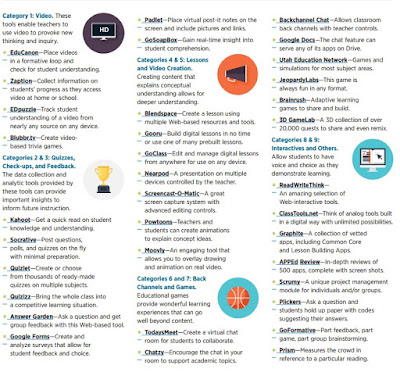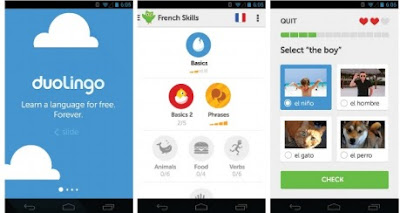According to edtech expert and blogger Michael Gorman, technology integration
needs to be a step-by-step process that amplifies the learning experience. With
this in mind, he has assembled a student-centered toolkit of free resources for
technology integration.
1 ClassTools.net features numerous tools—including social media, and graphic
organizers—that enable students to become creators and producers.
2 With Screencast-O-Matic, students create and edit their own videos to curate
curriculum and demonstrate learning. The videos can be saved for future
learning and exported to multiple locations.
3 The wonderful set of over 50 interactive tools that constitutes ReadWriteThink
can be used in any area of the curriculum.
4 Google Lit Trips uses Google Earth to bring an authentic reading experience
through literature to all grade levels and shows student how to make their own
trips.
5 The Right Question Institute teaches Question Formulation Technique (QFT), a
simple yet powerful technique to help students learn to ask their own questions
and take ownership of meaningful inquiry and research.
6 Weebly enables both teachers and students to create Web sites to enhance
the curriculum and demonstrate learning. Weebly is easy to use and offers a
variety of ways to demonstrate and engage.
7 With Blendspace, teachers can make lessons or use lessons from others,
allowing for differentiation and student self-regulation.
8 Quizziz is a classroom quiz game that allows for group learning and individual
reflection.
9 For classroom 1 to 1 management, Nearpod provides interactive lessons using
slide shows on each student’s device, with Web visits, slides, and assessments.
10 Students receive instant feedback with Formative, a tool for gauging
learning for individuals and whole groups.
This excellent guide for evaluating the usefulness and authority of Web resources provides an infographic with clear steps for students to follow, examples, and tips for determining a source’s
trustworthiness.
92% OF TEACHERS BELIEVE CLASSROOM DESIGN HAS AN IMPACT ON STUDENT LEARNING
According to various studies cited by Juliana on his blog (http://ajjuliani.com), an overwhelming majority of educators believe there is a direct link between classroom design and student performance:
* 99% believe that school design is important for creating a good learning environment.
* 89% believe it is important for teacher retention.
* 79% believe it is important for student attendance.
* The classroom environment can affect a child’s academic progress over a year by as much as 25%.
SURVEY SHOWS PARENTS OVERWHELMINGLY SUPPORT USING STUDENT DATA TO IMPROVE EDUCATION
A study just released by the New Future Privacy Forum focuses on the goals and fears
of parents concerning the use of technology and student data. Among parents surveyed:
71% say their child uses technology provided by the school.
76% understand what data are being collected and how they are used.
71% are comfortable with the creation of (properly protected) electronic education
records for their child.
The majority of parents are in favor of using student data to:
Identify struggling students (84%);
Personalize learning by identifying a student’s strengths and weaknesses (79%);
Improve the effectiveness of teacher instruction (78%);
Measure and hold teachers accountable for their effectiveness (73%).
OVER 35 FORMATIVE ASSESSMENT TOOLS TO ENHANCE FORMATIVE LEARNING OPPORTUNITIES
T&L adviser Michael Gorman prefers the term “formative learning” to formative assessment. Here he shares over 35 formative learning tools, in nine different categories, for integrating technology with good teaching.
DIGITAL RESOURCES FOR ELL STUDENTS AND THOSE LEARNING A FOREIGN LANGUAGE
By Lisa Nielsen
I took four years of Spanish during my school years, though
you wouldn’t know it if you tried to have a conversation
with me in Spanish. My experience is not unusual. The way
language is typically taught in the U.S. often does not result
in language acquisition. I wonder if things might have been
different had I been a student today, in a time when technology
provides such terrific resources for learning languages.
Here are five free digital resources that can support
students in language acquisition.
Duolingo has become a popular app to support
foreign language learning. Its gamification elements
make it both fun and addictive. You can earn points for
correct answers, race against the clock, and level up. The
bite-sized lessons are effective, and here is proof that it works:
more than 100,000 classrooms are using Duolingo. Teachers
can easily track their students’ progress, run in-class
activities, and assign homework.
Livemocha’s site explains that language is not just an academic subject
but also a performing art—something that students must actively
practice in order to master it. A learner can listen to people speaking a new
language, memorize all of the grammar rules, and talk about the language ad
nauseam. But to truly master a language, a learner must actually practice
speaking it with a partner. Conversational fluency requires good instruction, a
dose of courage, and a lot of real-life practice. Livemocha’s methodology is
structured around the Whole-Part-Whole learning model, a proven framework
that allows learners to observe, learn, and then practice new language
concepts.
The Livemocha community is made up of language enthusiasts: teachers, language experts, other language learners, and native speakers who are proud
of their language and heritage. Community members help each other learn in
a myriad of ways: they leave comments in response to practice exercises, build
mini-lessons within exercise feedback, hold practice conversations via text,
video, or audio chat, provide language practice and culture tips, and give much needed
encouragement (after all, learning a new language is not easy!)
Livemocha is available to students of all ages. Children under 13 must have
written authorization from a school or other educational organization that
registers them.
Dotsub: Subtitles are great for both increasing literacy in a native
language and for learning other languages. Citizens of Scandinavian
countries are renowned for their terrific English language acquisition, and this
is often credited to the fact that they grow up with subtitled English television
and so have plentiful exposure to the language.
Dotsub is a digital resource that capitalizes on the power of subtitles.































No comments:
Post a Comment